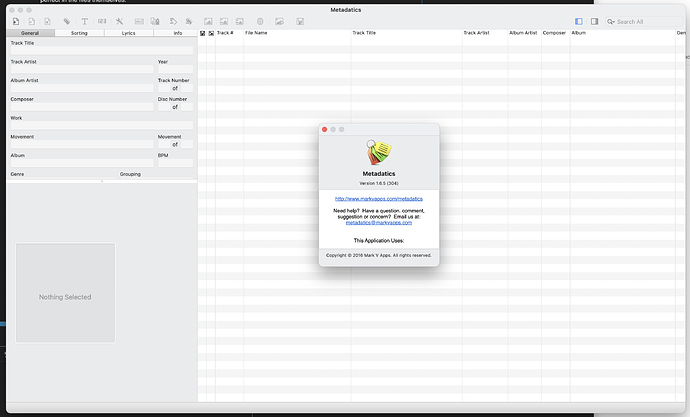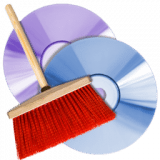At a glance
- Metadatics (Mac App Store link) is a powerful tool that’s a bit more efficient to use and offers more features for changing tags than iTunes. You can use it for basic tagging, as you would with.
- That's a pretty straightforward app. To start, I suggest you just drag a folder with ONE album in the Metadatics window or icon. Then you can edit the information on the side pane, and once you're done, just hit Save (Command+S).
Metadatics is a powerful audio metadata editor with many features. It supports batch editing of most audio file types including MP3, M4A, AIFF, WAV, FLAC, APE, OGG, WMA, and more. Edit multiple audio files at once quickly and easily. Whether you need to edit metadata in 1 or 10,000 files, Metadatics will handle your needs with ease. Metadatics is a powerful and advanced audio metadata editor. It supports batch editing of most common audio file types including MP3, M4A, AIFF, WAV, FLAC, APE, OGG, WMA, and more. Nov 24, 2020 Metadatics is not available for Windows but there are plenty of alternatives that runs on Windows with similar functionality. The most popular Windows alternative is Mp3tag, which is free.
Cons
Our Verdict
If you work hard to ensure that the music files in your iTunes library are tagged exactly right, you may be frustrated with iTunes’ tools for doing this. The iTunes 12 Info window—the one that displays when you select tracks and press Command-I—is less efficient than that of previous versions, and while there used to be a way to display the old-style window, you can no longer do so.
Metadatics (Mac App Store link) is a powerful tool that’s a bit more efficient to use and offers more features for changing tags than iTunes. You can use it for basic tagging, as you would with iTunes, when you rip tracks from CDs or add downloads to your library. But it goes much further.
When you use this app, you need to work on files in the Finder, not in iTunes, so it’s best to use Metadatics before adding files to iTunes. If you’ve already added files to iTunes and want to tag them with Metadatics, you should remove them from your iTunes library. To do this, drag the files from the iTunes window to a folder in the Finder, and then delete the files from iTunes. You’ll lose any personal metadata, such as play counts, last played dates, and ratings. (If you use Metadatics to tag files that are in your iTunes library, iTunes may lose track of their locations.)
Drag the files onto the Metadatics window and start tagging. If you select all the files, tags you change in the left-hand section of the window will apply to all of them, such as tor change Artist or Album tags. If you select just one file in the Metadatics window, you can alter just that file’s tags, such as its Track Title or Lyrics.
Metadatics offers a whole range of power features. It can search for tags on the MusicBrainz website, and it can search for album artwork on Amazon and Google. I wish the Google artwork search allowed you to specify the size of the artwork you prefer, such as 600-by-600 pixels. Metadatics just shows all the artwork it finds, regardless of size.
There is also a panoply of tools that allow you to manipulate text in tags. You can insert text in a tag, remove text from a tag, remove a number of characters, convert case, replace text, number files, and much more.
Serious iTunes taggers will be familiar with some of these features as tools available in AppleScripts from Doug Adams’ Doug’s AppleScripts for iTunes website. I often refer to these AppleScripts in my Ask the iTunes Guy columns, as ways of getting around iTunes’ limitations. Metadatics can do many powerful text manipulations, but you need to perform them outside of iTunes, whereas Doug Adams’ AppleScripts perform the changes in your iTunes library.
My only criticism of Metadatics is that I find the overall interface of the app to be a bit spartan. This can be a daunting app, because of all its features, and a bit of design might make it easier to work with.
Itunes Metadata Tool
Bottom line
If you’re the type of person who needs a tool like this, you’ll quickly recognize how powerful Metadatics is. I’ve only touched on the most commonly used tools in this review: Metadatics has many more tricks up its sleeves, so if you care about your music files’ tags, this app can save you a lot of time.

Metadata + Music :: What is it and Why is it so important?
We’re increasingly living in a world built around metadata, which is the descriptive information about the primary data like a song file. Metadata is often overlooked by songwriters, artists and bands because it takes time and some additional research that many just don’t want to put it. Metadata is becoming more and more important though, as we move into the age of streaming music.
What is metadata?

Proper definition: a set of data that describes and gives information about other data.
In other words, metadata is information that will help to describe your music as well as provide contact information for those looking to contact you to use your music. We are in the digital age, so CD’s are a nice package but it is the digital file that ends up getting stored and saved. So tagging your music files with the appropriate metadata is key. And it does more than that. Having the files properly tagged will also tell them a bit more about the music and help them narrow down their music choices.
Why is it important?
The metadata of a song contains all the info about who should get paid, including songwriters, publishing company, record label, and performing rights organization.
That alone should be enough reason to fill in the blanks. But another big reason is that because song placement on film and television is so important to an artist’s income these days, metadata has become vital to the very people who decide what makes the cut – music supervisors.
Filling Out Your Song Catalog
If you haven’t already, you should start creating a song catalog using a spreadsheet program or other programs. There are several bits of information that you should have for your metadata.
Mac Metadata Editor


Metadatics For Mac
The Guild of Music Supervisors recommends that as much information as possible be included in the metadata of all digital music submissions, with underlined content being required.
In order to cover all your metadata needs, here’s what to include with every song, especially if you’re trying for a sync placement:
- Song Name
- Artist
- Contact Information (email/phone)
- Genre
- Subgenre
- Composer (s) – with PRO info and splits
- Song Summary
- Mood
- Key words
- Instruments
- BPM/tempo
- Key
- Lyrics
- Year of Copyright/year created
It seems like a lot of info, but if you want a placement, it’s all vital in rising above the competition.
10 Audio Metadata Editors
Here are a number of suggestions for some metadata editors, since many DAWs don’t provide extensive access to many of the metatags that are needed. Here’s a list of 10.
iTunes – There’s a nice editor right within the app.
Metadatics – This is Mac only and costs $9, but it also covers a wide range of file formats.
Tag – A fairly simple Mac only editor that’s free.
Tuneup – This is a Windows and Mac editor that has both a free and premium version.
ID3 Editor – A simple Mac editor that provides most of the metatag needed. Free.
Musictag Editor for Mac – free to try up to 10 times, then $5.99.
Musicbrains Picard – This is a pretty geeky editor that cross platform, but it’s very extensive if you get down inside it. And it’s free.
Easeus data recovery full mac mega. UDTE-ID3 – Another PC only editor that supports a wide range of file formats.
MediaMonkey – An iOS tag editor that supports multiple file formats.
Metadatics Windows
WaveAgent – A very cool Wave file editor for both PC and Mac.
If none of these 10 seems to fit your needs, there are plenty of other audio editors available. Just do a Google search and find the one that suits you best.
Metadatics Mac
Read more: Synchtank blog on Guild of Music Supervisors Metadata Standards
